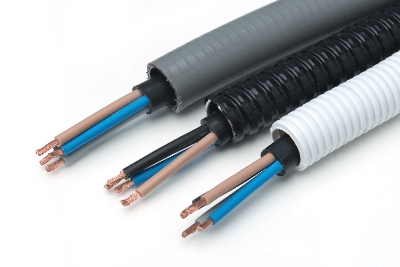What Is Cable Protector?
 A cable protector is a product that protects various types of wiring from force and electrical action.
A cable protector is a product that protects various types of wiring from force and electrical action.
They come in a variety of shapes, including holders, bushings, and spiral tubes that converge. Of these, the tube type is particularly common, and can be further classified into those with snap-button fastening, those with slits, and others.
Three typical tube types are corrugated tube, spiral tube, and net tube. The appropriate one is selected according to the location and intended use.
Uses of Cable Protectors
Cable protectors are often used for bundling door crossings, protecting wiring in panels, and binding harnesses for electronic components. A cable protector is characterized by its ease of use in terms of flexibility and durability, as well as its superiority in binding wiring. Different types of cable protector are used for different purposes.
1. Corrugated Tubing
Corrugated tubing, which has a bellows shape with slits, is widely used to protect wiring harnesses, especially in automobiles, construction machinery, agricultural machinery, home appliances, and residences.
2. Spiral Tubing
Spiral tubing is often used as a cable protector for cables and hoses routed to moving parts of industrial machinery.
3. Telescopic Braided Tubing (Net Tubing)
Expandable braided tubing (also known as net tubing) is characterized by its light weight and flexibility. Because of its flexibility as cable protector, it is used for wiring in airplanes, concerts, theaters, sound and lighting equipment, etc.
4. Grommets
Grommets are used in protecting wiring from damage from holes in panels, such as wiring pullouts.
Principles of Cable Protectors
A cable protector basically protects the wiring by covering the wiring with a tube or similar material around the wiring. A cable protector with slits in it is easier to insert the wiring. The part number is selected by comparing the inner diameter of the wire that fits the protective material with the natural inner diameter of the tube. In addition, since the use of the tube changes depending on its material, proper selection is required.
1. Polypropylene
Polypropylene is an insulating material and, as a result, does not conduct electricity It is often used for standard tubing because of its flexibility and resistance to cracking. It is inexpensive and available in a wide range of sizes and colors.
2. Nylon
This material can withstand temperatures as high as 100°C and is insulating. It tends to be slightly harder and more expensive than polypropylene. It has excellent weather resistance and is preferred for outdoor use.
3. Nylon Containing Rodent Repellent
It can reduce damage caused by rodents when used indoors or outdoors. It is designed to cause irritation and pungency when gnawed by rats, preventing wire breakage.
4. Chlorotrifluoroethylene
It is elastic, slippery, and heat resistant up to about 150℃. It is expensive.
Other products, such as silicon braided and glass braided tubes, have high self-extinguishing properties and heat resistance up to about 180°C.
Features of Cable Protector
1. Corrugated Tubing
Corrugated tube is one of the wiring protection tubes used as a wiring protection material. It is also one of the wiring harnesses that bundle multiple wires and wiring used for power supply and signal communication, etc. It not only bundles wires and wiring but also protects them from various external shocks.
The wave-shaped surface of the tube makes it softer and easier to maneuver than standard tubing. This allows them to be used in tight or oddly shaped spaces. Tubes are available in a wide variety of lengths, from short to long, and can be cut with scissors to adjust the length according to the conditions of use.
Tubes are made of two main materials: polypropylene and nylon. Polypropylene is a flexible and durable material that is widely used for indoor applications. Nylon has a higher unit price, but is more resistant to deterioration, making it suitable for outdoor use. Another appeal of corrugated tubing is that you can choose the most suitable material for your application.
2. Spiral Tube
Spiral tube is a tube designed to protect wiring. Since it is a resilient material, it is widely used as industrial cables and tubes, taking advantage of its elasticity. In addition to the purpose of wire protection and banding, it is also used for organizing wiring. When used to organize wiring, it is very easy to band the wires to be banded in one place and wrap the outer frame with the tube.
Spiral tubes are characterized by their tube-like shape that wraps around in a spiral. Spiral tubing is made of various materials such as nylon, polyethylene, and fluoroplastic as well as plastic.
3. Elastic Braided Tubing (Net Tubing)
Net tubing is a soft type of tubing that is braided using a special manufacturing process and can be cut from anywhere with scissors. It can be cut immediately, allowing for efficient and easy protective bundling. It is also attractive because it retains its attractive appearance even when cut.
In addition, the net tube has a braided structure that can be maintained for a long period without heat or moisture buildup inside the tube, and its high netting density provides excellent product protection. These tubes are ideal for use in protecting wires in moving parts.